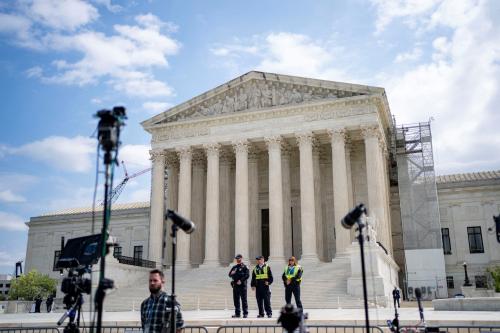Executive Summary
Federal judicial selection is a time-consuming and sometimes contentious process. Home state senators, particularly those of the president’s political party, have historically enjoyed the prerogative to propose nominees to the White House; most identify those potential nominees through relatively informal means. This paper describes alternatives to those informal means that may be more open, transparent and inclusive, but that still preserve the senators’ prerogative: senator-appointed committees to screen potential nominees.
The Governance Institute and the Institute for the Advancement of the American Legal System prepared this paper to describe, from the admittedly limited information currently available, how such screening committees have been constructed and how they typically work. It outlines factors that senators and their staffs may wish to consider in creating a committee, and highlights issues to consider with respect to committee operations. Our goal is to identify some of the choices that the legislators and their staffs, and committee members, will face, and to suggest an array of options; our goal is not to prescribe “best practices.”
Screening committees have been in use by some senators for more than 30 years. In 1977, President Carter created a national committee to screen potential nominees for the U.S. courts of appeal, and he urged senators to appoint their own committees for district judgeships. Senators in 29 states responded, although by the time of President George W. Bush’s administration, senators in only nine states had committees in place. In 2008, the American Bar Association reaffirmed its support for the use of committees, and 2009 saw an upswing in their use.
The number of committees shot up from nine in 2008 to at least 21 as of mid-June 2010. Nevertheless, information on their operation—even their existence—is not abundant, despite the best efforts of the American Judicature Society to identify and describe them. We have relied here on the Society’s website list of senators who use committees[i] as well as information from the Congressional Research Service, legislators’ websites, press reports, and conversations with committee members. Cumulatively, this information provides insight into the value that senators perceive screening committees to provide, as well as the factors to consider in structuring, appointing, and operating a committee.
The reasons why senators may choose to use screening committees include a hope that an individual who enjoys the endorsement of a committee may move to nomination and confirmation more quickly. That aspiration appears to have held true to some extent, although differences in confirmation times are affected by factors other than the committee process. Other advantages of a committee process may include the ability to screen applicants and catch problems before any ABA or White House involvement; providing a voice to varied constituencies, including non-lawyers and members of both political parties; and inviting applications from individuals who might not otherwise come to the senators’ attention.
The composition of committees varies widely, in the number of members, leadership, and demographics. Similarly, charges from the senators as to committee tasks and operations vary as does the jurisdiction of the committees. The first decision is whether the committee will be created by one or both senators. Recommendations of a committee that has the support of both senators—whether or not of the same political party—may have more traction than those of a single-senator created committee.
We also remind committees that individuals, once nominated, will undergo vigorous examinations by the Federal Bureau of Investigation, the American Bar Association Standing Committee on the Federal Judiciary, the Senate Judiciary Committee (which will post lengthy, nominee-completed questionnaires on its website), and sometimes by the press. Problems that surface in these investigations but that the committee missed might marginalize the committee in the eyes of the senators and the informed public.
Below is a decision tree for senators and their staff about creating a committee, and for committee members as well, about its operation: what are the decisions to be made and what are the options among which they will likely choose? The goal is to provide senators, staff, and committee members with a roadmap drawn from the experience of other senators.
REASONS to consider the use of screening committees:
- Ease contention and delay in the nomination-confirmation process
- Anticipate and complement ABA reports
- Provide a voice not from the president’s party, without compromising the ultimate choice, to preserve partisan prerogatives in the appointment
- Open the process to more applicants
- Enhance public trust in the process
STRUCTURE of the committee:
- Creation by one or both senators
- One or more committees: a geographic question
- Bar association collaboration
- Jurisdiction of the committee: district judges only, or circuit judges, U.S. attorneys and/or marshals as well
- Permanent or ad hoc
- Committee size
- Formal bylaws or other governing documents, or informal process
APPOINTMENT of the committee members:
- Lawyers only or lawyers and lay persons, and what mix of trial lawyers and other lawyers
- Political representation/bipartisanship
- Demographic representation
- Judge participation
- Chair, co-chairs: independence, visibility, experience
OPERATIONS of the committee:
- Guidance from the senator(s)
-
-
- Criteria for evaluating applicants
- Confidential parts of the process versus public parts
- Roles of the senators’ staff
- Whether the senators will interview the candidates
- What information the senators want from the committee in addition to names
-
- Funding committee operations
- Application process: notice, form, deadlines
- Developing the list of potential nominees to be vetted: procedures to govern the committee’s decisions/process in advance (even if informal)
- Background research: who does it, how much and what portions are confidential
- Organizing and conducting interviews
- Releasing information: when, how much
This document will evolve over time. It is a living document, because each experience with the use of committees can further inform the next committee if the information is shared.
[i] http://www.judicialselection.us/federal_judicial_selection/federal_judicial_nominating_commissions.cfm?state= FD.




